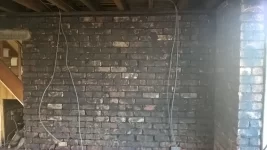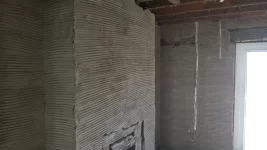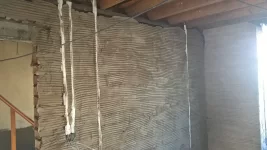Hi all, my names Aaron, I've browsed this forum lots of times in the past for different bits and bobs but am now finally registering to ask some advice on the plastering in my first home.
Late 1920's cavity wall soft redbrick construction, it had a thin lime screed floor with no dpm which was starting to fail and letting damp in, as well as lots of damp patches on all the ground floor walls.
After a lot of research and surveys, we've done a lot of work on the property to sort the damp - new floor, lowered ground outside, cleared all the cavities and injected dpc throughout.
I know there is divided opinion on chemical injection dpc's, and so we debated for a long time before deciding to go ahead, especially as the original mortar/plaster was all lime based and a chemical dpc also requires a sand and cement backing to be applied with waterproofer/salt inhibitor - I've read that cement on lime buildings can create it's own problems.
Anyway, we went ahead with the dpc, and stripped all original plaster off the walls (not just up to 1.2m high) as it was blown in places anyway. We let the bricks dry for a couple of months with the intention of sand/cementing the lot and finishing with multi.
Our builder recommended a plasterer to us as it was a bit difficult finding someone who was willing/able to apply the sand and cement backing. I wanted to get the pros in for this and finish with multi myself (I've skimmed a few rooms before and enjoy it). The plasterer and his guys have today applied the first coat.
The plasterer is adamant that we should not skim the sand/cement as he believes that it is certain to crack on our type of wall. He instead suggests that we should dot and dab the lot. He says that after a few months with heating on it wall all crack in a jigsaw puzzle shape. He didn't really give much more of an explanation other than 'these types of walls are so dry it will take all the moisture out and crack'.
I was really hoping to skim the sand and cement as the walls have character and I'm not too keen on dot and dab because of the voids it creates and how much more work it is to get decent fixings down the line.
All the walls are soft red bricks with black ash mortar. I've got no reason to disbelieve the plasterer, but was just hoping to gather some opinions on here and maybe explore some solutions. Photos attached.
Aaron
Late 1920's cavity wall soft redbrick construction, it had a thin lime screed floor with no dpm which was starting to fail and letting damp in, as well as lots of damp patches on all the ground floor walls.
After a lot of research and surveys, we've done a lot of work on the property to sort the damp - new floor, lowered ground outside, cleared all the cavities and injected dpc throughout.
I know there is divided opinion on chemical injection dpc's, and so we debated for a long time before deciding to go ahead, especially as the original mortar/plaster was all lime based and a chemical dpc also requires a sand and cement backing to be applied with waterproofer/salt inhibitor - I've read that cement on lime buildings can create it's own problems.
Anyway, we went ahead with the dpc, and stripped all original plaster off the walls (not just up to 1.2m high) as it was blown in places anyway. We let the bricks dry for a couple of months with the intention of sand/cementing the lot and finishing with multi.
Our builder recommended a plasterer to us as it was a bit difficult finding someone who was willing/able to apply the sand and cement backing. I wanted to get the pros in for this and finish with multi myself (I've skimmed a few rooms before and enjoy it). The plasterer and his guys have today applied the first coat.
The plasterer is adamant that we should not skim the sand/cement as he believes that it is certain to crack on our type of wall. He instead suggests that we should dot and dab the lot. He says that after a few months with heating on it wall all crack in a jigsaw puzzle shape. He didn't really give much more of an explanation other than 'these types of walls are so dry it will take all the moisture out and crack'.
I was really hoping to skim the sand and cement as the walls have character and I'm not too keen on dot and dab because of the voids it creates and how much more work it is to get decent fixings down the line.
All the walls are soft red bricks with black ash mortar. I've got no reason to disbelieve the plasterer, but was just hoping to gather some opinions on here and maybe explore some solutions. Photos attached.
Aaron



